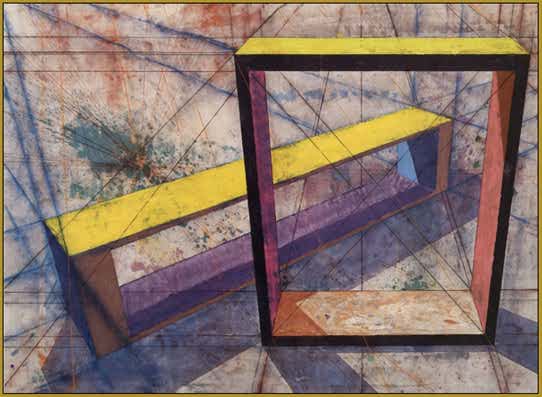
page 2
The objects of Davis's later paintings and lithographs, as well as the concepts of Einstein's mature mind, are more complex, and their relationship to one another more tenuous. The objects are elusive. Their size, for example, is ambiguous, owing to the absence of scale. The planes can be seen either as paper-thin three-dimensional walls, or as true two-dimensional surfaces. The shadows have, to some extent, become detached and have acquired an independent existence. Thus the objects hover enigmatically between concreteness and abstraction. They share this quality with the mathematical models physicists use to imitate the world. Consider, for example, the earth's gravitational field, a concept that can be defined mathematically and used to make predictions, but that can't be understood intuitively the way a rock can, or a volume of air, or even space can. We imagine gravity all around us, affecting our every move, but we don't really know what it is. The gravitational field, and the other devices that physicists construct to model the world, are located, like Davis' objects, halfway between reality and imagination.
Frame and Beam, 1975
114 x 157 inches, Acrylic and dry pigment on canvasA conspicuous element common to Einstein's thinking and Davis's painting is the frame of reference. Einstein drew an astonishing wealth of far reaching conclusions from careful attention to the simple fact, obvious to painters, that the description of a physical phenomenon depends on the observer's point of view. Without exception Einstein's first question about a new problem was: What is the frame of reference? Where is the observer? So it is with Davis. The device he uses to define the frame of reference in Frame and Beam (1975), as well as in most other works of this period, is the snapline. As a guide for construction, builders stretch a string drenched in chalk tightly against a flat surface. When they pull the string up, and let it snap back against the surface, it leaves a clear, straight chalk line, or snapline. With dry pigment substituting for chalk, Davis constructs multi-colored grids from snaplines, according to the rules, selectively interpreted, of perspective. To clarify spatial relationships even further, Davis always paints from a fixed point of view, above the object. The consistency of this perspective draws attention to the position of the painter and reminds us that in art, as well as in physics, the observer cannot be entirely detached from the observed. Ron Davis is always there, an unseen cicerone behind our shoulder, pointing out the subtleties of his vision.
